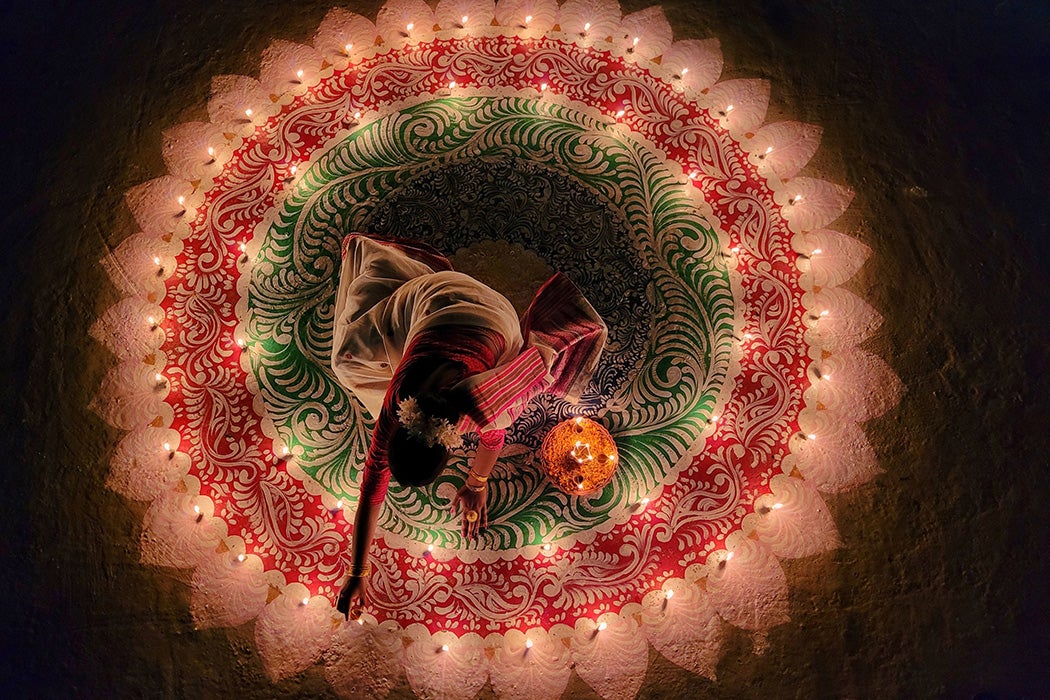Numerous Hindu festivals are celebrated in the month of October, including Dussehra, Durga Puja, Karwa Chauth, and Diwali (Divali). The last of these, also known as Deepavali, is described as the festival of lights. Celebrations typically involve the lighting of candles and lamps, bursting of firecrackers, and offering of prayers to the gods and goddesses of wealth and prosperity. Diwali is observed across the length and breadth of India as well as among the large Indian diaspora around the world, yet the historic trajectory of this festival as recorded in literature and academic scholarship hasn’t received much attention.
In 1945, P. K. Gode, a Sanskrit and Prakrit scholar, sought to change this. He examined the history of the festival through written records in his paper “Studies in the History of Hindu Festivals—Some Notes on the History of Divālī Festival—(Between c. AD 50 and 1945),” published in the Annals of the Bhandarkar Oriental Research Institute.
Outlining his intentions behind this monumental task, he explains that
in India with its numerous religious beliefs we have quite a bewildering variety of religious and semi-religious festivals but unfortunately much of the writing devoted to these festivals is of a descriptive type, in which no attempt is made to fathom the depths of available historical sources with a view to reconstructing any reliable history worth the name.
Through the in-depth study of published material in reverse chronology, he highlights how the festival has “enriched the social, religious and cultural life of India.”
First, he turns to a 1916 publication titled History of Aryan Festivals written by an author known only as Rgvedi, who described Diwali as a seasonal festival. It was celebrated at the end of the month of Aasvin (Aashan) and on the new Moon and four first days of the month of Kaartik of the Hindu calendar, signaling the onset of colder weather.
Having established this, Gode quotes B. A. Gupte on the importance of examining the folklore surrounding a festival, noting that “the greater the number of folk-tales, the higher the stage of development in the society, and the greater the interest we find attached to the evolution of the festivities.” Hence, apart from marking the seasonal change, Diwali was celebrated when the rice-crop harvest ended, giving way to the manuring of the next crop, as well as to celebrate the coronation of Lord Rama from the epic Ramayana, among other cultural events.
In 1903, in the Hobson-Jobson historical dictionary of Anglo-Indian words and terms in use during British rule in India, Henry Yule and A. C. Burnell traced the meaning of “Dewally” from the accounts of foreign travelers dating back to 1613. They describe the festival as “an autumnal feast attributed to the celebration of various divinities, as of Lakshmi and of Bhavani, and also in honour of Krishna’s slaying of the demon Naraka, and the release of 16,000 maidens, his prisoners.”
However, the timing of celebration and rituals were often at variance among different communities and in different parts of the country. For example, Diwali celebrated by followers of the Jain religion differed from that of the Hindus. Gode notes that Margaret Stevenson, in her entry “Jain Festivals and Fasts” in the Encyclopaedia of Religion and Ethics (1912), described its importance to the mercantile community of Jains, who prayed exclusively to Lakshmi, the goddess of wealth. Through Stevenson’s account, Gode assessed that Diwali was perhaps celebrated by the Jains throughout their existence, dating back to the death of Lord Mahavira 2,400 years ago. Buddhist celebrations of Diwali were recorded by G. E. Gerini in his entry “Siamese Festivals and Fasts,” published in the same encyclopedia. He referred to the Buddhist celebration as “the feast of lamps which is a counterpart of Hindu Diwali or Dipawali.”
Gode also examined Diwali celebrations in different locations. He notes a reference to Diwali in 1030 CE in Iranian scholar and traveler al-Biruni’s account of the “Festivals and Festive days” of the Hindus in north India. As for the southern part of the subcontinent, records also mention Diwali being celebrated in the Deccan at Kolhapur in the eleventh century. A Kannada inscription dating back to 1119 CE, written during the reign of Chalukya Tribhuvanamalla, referenced Dipavali as well. Abul Fazl’s Ain-i-Akbari, written in 1590 and which captured life during the reign of Mughal emperor Akbar, compared Diwali to the Muhammadan festival of Shab-i-baraat. And the Marathas in the west celebrated it in the eighteenth century, as evident from a chronicle written during Mahadji Scindia’s time (1727–1794 CE).
Weekly Newsletter
Digging deep into the archive, Gode writes that in the sixth and seventh centuries CE, Diwali was referenced in the Nilamata Purana of Kashmir and Sri Harsa’s play Nagananda. However, the oldest reference he found came from the Kamasutra (50–400 CE), which mentions a festival called Yaksharatri. Twelfth-century scholar and Jain saint Hemachandra equated this celebration to Diwali in his Desi-nama-mala (also known as Deshi-Shabda-Sangraho), a lexicon of words that originated outside of Sanskrit.
Finally, collating the history of the festival chronologically in a table, Gode concludes, “I am firmly convinced that without a chronological account of our festivals we cannot understand their history.”







